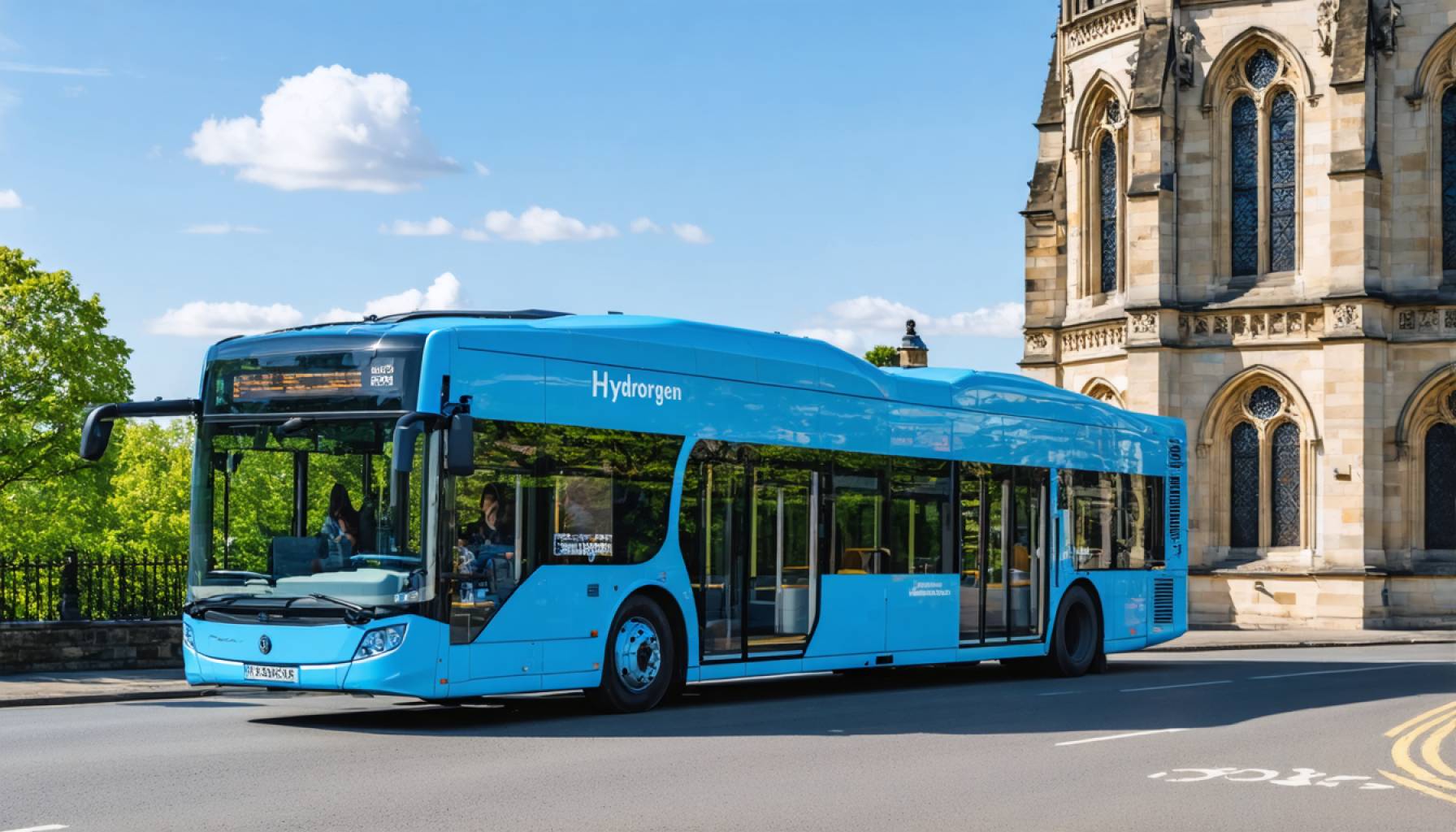- The UK hydrogen bus market is advancing, driven by sustainability and green energy efforts.
- Government incentives and policies support the transition from diesel to zero-emission hydrogen buses.
- Hydrogen buses offer a clean alternative, emitting only water vapor, supported by advancements in fuel cell technology.
- Despite high initial costs and competition from battery-electric buses, industry giants are investing in hydrogen infrastructure and innovation.
- The market is expected to reach a valuation of GBP 810 million by 2035, with a compound annual growth rate of 23.9%.
- Hydrogen buses contribute to cleaner air and play a significant role in meeting the UK’s goal of net-zero emissions by 2050.
- The UK exemplifies the potential of hydrogen buses as a step toward a sustainable future.
Beneath the foggy skyline of cities like London and Aberdeen, an automotive revolution quietly powers up. As the world tightens its embrace on green energy, the UK hydrogen bus market surges ahead, fueled by innovation and a determined leap toward sustainability.
With the hum of progress almost audible in the air, Britain rides the wave of a hydrogen-fueled future. The government, donning the cape of ecological savior, strides forward with incentives and policies that favor a switch from the diesel-drenched past to a cleaner, greener promise. Hydrogen buses, once a mere gleam in the eye of environmentalists, now stand as solid beacons of zero-emission commuting.
Imagine a bus that glides almost soundlessly through crowded urban landscapes, emitting nothing but water vapor. Such imagery is becoming the new normal, courtesy of advancements in fuel cell technology and burgeoning refueling infrastructures.
Yet, the journey isn’t without hurdles. The high initial costs of hydrogen buses remain a dragon to slay, and battery-electric buses nip at their heels in competition. The market, however, remains optimistically aggressive, with industry giants pooling resources and innovations to widen hydrogen’s appeal and accessibility.
The numbers tell a tale of compelling transformation. By 2035, this unassuming but powerful fleet is projected to rocket to a staggering valuation of GBP 810 million, pushed along by a compound annual growth rate of 23.9%. These growing fleets are not just about economics; they’re a lifeline to cleaner air and a pivotal piece in the puzzle of the UK’s target to achieve net-zero emissions by 2050.
In the race toward a zero-emissions future, the UK showcases how hydrogen buses are not just vehicles—but vessels steering us toward a cleaner, sustainable horizon.
Could Hydrogen Buses Hold the Key to a Greener Tomorrow?
How-To Steps & Life Hacks: Implementing a Hydrogen Bus System
1. Assess the Demand: Begin by conducting a feasibility study in your city to determine public transportation needs and the potential for hydrogen buses.
2. Infrastructure Development: Invest in creating a network of hydrogen refueling stations. Collaboration between government and private sectors can help reduce costs and spread implementation.
3. Government Support & Funding: Leverage any local or national grants, subsidies, and other fiscal incentives available to promote hydrogen bus adoption.
4. Pilot Programs: Initiate pilot programs to test hydrogen buses on select routes, gather data on performance, and adjust logistics as needed.
5. Community Engagement & Education: Inform and engage with the community about the benefits of hydrogen technology to bolster public support and adoption.
Real-World Use Cases
– London and Aberdeen: Both cities are pioneers in integrating hydrogen buses, reducing urban emissions and serving as models for other cities globally.
– California, USA: Known for its progressive adoption of hydrogen vehicles, California has developed one of the more robust refueling infrastructures outside of Europe.
Market Forecasts & Industry Trends
– Global Expansion: The global hydrogen bus market is expected to grow significantly, driven by increasing environmental regulations and government initiatives favoring cleaner public transportation options.
– Technological Innovations: Advancements in hydrogen storage and fuel cell technology continue to improve the feasibility and efficiency of hydrogen buses.
Reviews & Comparisons
– Hydrogen Buses vs. Battery-Electric Buses: Key differences lie in refueling time and range. While hydrogen buses can be refueled faster and typically have a longer range, battery-electric buses are often seen as cheaper initially and require less maintenance.
Controversies & Limitations
– High Initial Cost: The upfront cost of hydrogen buses is still higher compared to conventional and battery-electric buses, mainly due to the cost of fuel cells and infrastructure.
– Hydrogen Production: Criticism arises over the current methods of hydrogen production, which are often not entirely green. Transitioning to “green hydrogen,” produced via renewable energy, is key to addressing these concerns.
Features, Specs & Pricing
– Key Features: Hydrogen buses emit zero emissions, possess a quiet operation, and have a range often exceeding those of battery-electric buses.
– Pricing: Prices can range significantly, but subsidies and incentives often make them more competitive over time.
Security & Sustainability
– Refueling Safety: Hydrogen stations are designed with robust safety systems to prevent leaks or accidents.
– Sustainability Factor: Hydrogen buses have the potential to significantly reduce urban air pollution and contribute to achieving long-term climate goals.
Pros & Cons Overview
Pros:
– Zero emissions during operation
– Quick refueling times
– Greater range compared to electric buses
Cons:
– Higher initial costs
– Limited refueling infrastructure
– Current hydrogen production methods can be environmentally harmful
Actionable Recommendations
– Explore Incentives: For cities or transit authorities, actively search for government subsidies or partnerships to alleviate costs associated with the transition.
– Monitor Technological Trends: Stay informed about advances in hydrogen production and fuel cell technologies.
– Start Small: Begin with a small fleet of hydrogen buses to assess viability before scaling up.
For more information, explore resources on green transport technologies at the UK Government and International Council on Clean Transportation.


